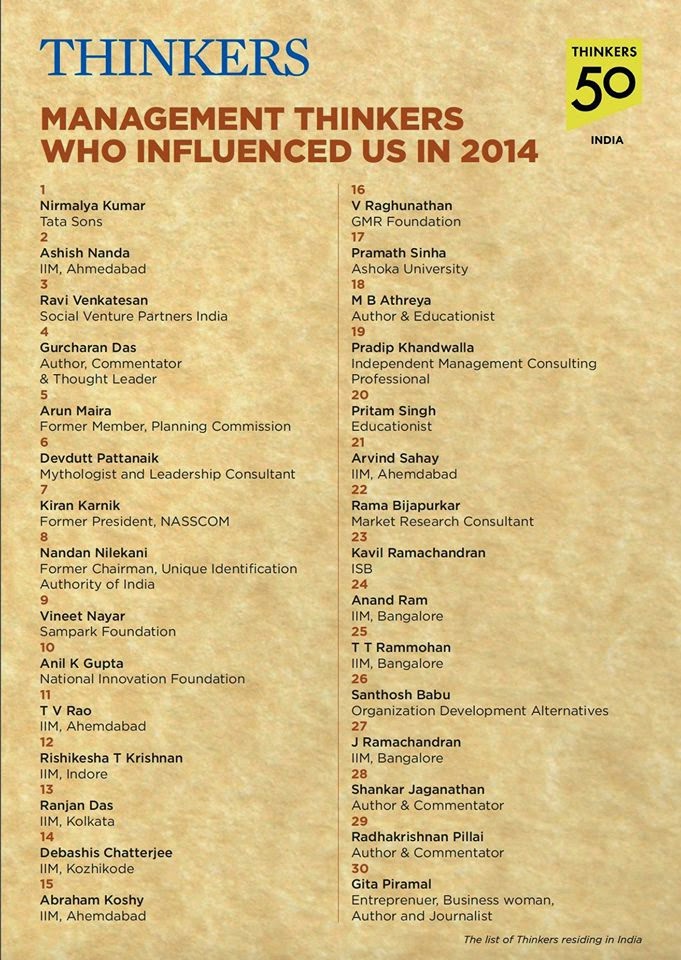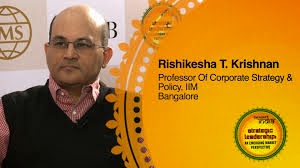The annual Indian Management Conclave (IMC) organized by
MBAUniverse.com has become an important event to take stock of the state of
management education in India and to identify new ways forward. At the
insistence of MBAUniverse.com Chairman Amit Agnihotri, I attended the fifth IMC
last weekend. Amit had managed to put together a good set of speakers
including several from overseas (many through video). Unfortunately, I managed
to catch only the second day of the event.
Indian Management Education: Vision 2025
One of the highpoints of this year’s IMC was the release of
a document titled “Indian Management Education: Vision 2025” (the photo below
shows B-school deans discussing the report). Frankly, I was quite skeptical at
first, but upon reading the document I realized that it has some good points.
It starts with a useful historical perspective that brings out the steady
evolution of Indian management education till the explosive growth over the
last two decades. There is a simple SWOT analysis that brings out the current
status of different categories of management institutes and programmes.
Indian management education is clearly heterogeneous and not
all business schools can or should have the same agenda. Therefore, one thing I
particularly liked about this vision document is the attempt to segment Indian
management education into 3 distinct segments.
Vision 2025 sees India creating 50 “global” business
schools, 500 “national” business schools and 2000 “skill-based” business
schools. The global business schools will have one of the three global
accreditations, be known for their research and thought leadership, be ranked
internationally and have international students as part of their student body.
The national business schools are seen as aligning with at least one important
dimension of India’s national development agenda and focused on meeting
national needs. And the “skill-based” business schools will be linked to the
Skills Development Mission of the country and meet clearly defined skills
requirements as emerging from new initiatives like the National Skills
Framework.
China has done better than India
The Vision 2025 document brings out some sharp contrasts
between India and China in the realm of management education. Though China
embarked on management education only two decades ago, it has done much better
than India in terms of accreditation and global rankings. But the document does
not explore in detail why there is this difference. From what I have read and
heard, here are a few things that China has done to advance high quality
management education:
- Encouraged reputed international scholars to work in Chinese institutions by creating chairs and special positions;
- Encouraged collaboration with top international institutions – e.g. China Europe International Business School (CEIBS) at Shanghai;
- Used dollar-equivalent salaries to attract Chinese scholars living outside China to return to Chinese institutions (this goes beyond management education to all disciplines of higher education);
- Brought in strong publication requirements in business schools (again, across the higher education system) matched by generous incentives;
- Used existing universities in Hong Kong and new ones such as Hong Kong University of Science & Technology (HKUST) to attract foreign scholars;
- Made a special effort to attract journal editors and other academic gatekeepers to spend time in Chinese academic institutions.
In 1999, I attended the inaugural meeting of the Asia
Academy of Management in Hong Kong. HKUST, which was one of the hosts of the
conference, had just hired Anne Tsui as the Dean of its business school.
Professor Tsui was by then an accomplished scholar in the United States and
editor of one of the top management journals, Academy of Management Journal. I
heard on the grapevine that this was a strategic hire, based on the assumption
that this would give scholars in Hong Kong and China easier access to the
editor of a top journal.
The contrast with India is sharp. Until Ashish Nanda and
Sushil Vachani were recently appointed to directorial positions at IIMA and
IIMB respectively, except for a brief spell when renowned Marketing scholar
Vijay Mahajan was dean of ISB from 2001-03, Indian business schools have never
hired top academics as deans even though the higher rungs of US academia are
filled with Indians.
Can 50 Indian business schools break into the global ranks?
Perhaps, but the more relevant question is how do you get there? The Vision
2025 document does talk about research and thought leadership. These words have
been bandied about for quite some time now, amidst comments from several
stakeholders that Indian institutions are “laggards in research” (this phrase
is used in this Vision 2025 document as well).
Creating 50 Global Business Schools
The Vision 2025 document takes India as a whole as its unit
of analysis. But I see significant challenges at both the national level as
well as the individual institutional level if India is to get anywhere near the
magical figure of 50 global business schools.
I would like to focus on just two challenges here, and will
return to this theme in later posts. Both of these relate to faculty.
If we are to create 50 global business schools, we need at
least 3,000 high caliber, productive faculty (assuming 300 students admitted
each year to the MBA programme and a student-faculty ration of 10:1). While
some institutions like the older IIMs are well endowed on this dimension with a
faculty size of about 100 faculty each, there is an acute shortage of faculty
who can combine good teaching abilities with the motivation and ability to do
good research.
Urgently Needed: A Bold Initiative to Address Shortage of
High Quality Faculty
How do we overcome this shortage?
When IIMA was started in the 1960s, India lacked a strong
tradition of management education and hence there were few faculty available in
management disciplines. IIMA recruited talented young men and sponsored them to
do a PhD in the US, including at Harvard Business School. Some of these faculty
later became the mainstay of the IIMA faculty body.
When I was a graduate student at Stanford in the 1980s, my
roommate who was a lecturer at the National University of Singapore was fully
sponsored by NUS to do his PhD. Of course, he later returned to NUS and works
there as a professor even today.
If we are serious about this target of having 50 global business
schools, we need a bold initiative on a large scale to address the faculty
issue. Taking a cue from the IIMA and NUS examples cited above, the government
should consider an initiative to sponsor 100 highly talented individuals with
Masters degrees from our leading institutions every year to top quality doctoral
programmes in the US and selected other countries. In ten years, we will have
around 500 well-trained faculty who can spearhead management education in India
for the next 25-30 years. Care should be taken to ensure diversity on all
counts in this initiative.
Transforming the Identity and Self-image of Faculty
There is a second issue which I believe will need to be
addressed if this dream of 50 global business schools is to become a reality:
Faculty in these schools will need to view themselves differently from the way
many faculty in India do today.
The principal identify of an Indian faculty member is as a
teacher. The nobility of teaching others is ingrained in us (even if we as a
society don’t extend the same respect to teachers as we did in the past!). In
most cases, research is seen as an additional chore, not as an integral part of
one’s role as a faculty member.
But, as has been mentioned in the Vision 2025 document,
research and thought leadership are integral to creating 50 global business schools.
So, this self-image of faculty has to change if we are to get anywhere near
this goal. This requires changes in our institutional processes as well as in
our doctoral programmes.
Inducting 500 faculty from top doctoral programmes outside
India as outlined above should help because foreign PhD programmes in top
schools do a good job of moulding their students and creating a strong
orientation towards research. But change within our institutions will be needed
as well to sustain the momentum of research once these individuals join our
institutions as faculty.
My talk at IMC was on “Creating Management Thought
Leadership from India,” and that will be the subject of my next post.
[The views expressed here are the personal views of the
author.]



















No comments:
Post a Comment